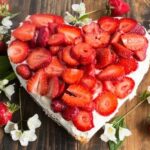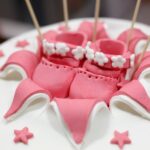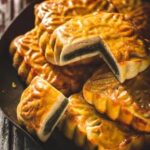Decorative cakes have captivated the hearts and taste buds of people around the world for centuries. These edible masterpieces not only satisfy our cravings for something sweet, but also serve as a canvas for creativity and artistry. From intricately designed wedding cakes that reflect love and celebration to personalized birthday cakes that showcase personalities and passions, decorative cakes have become an essential element of special occasions and milestones in our lives.
The art of designing decorative cakes dates back to ancient times, where they were used to symbolize prosperity, fertility, and joyous celebrations. Over the years, this culinary art form has evolved with changing trends and tastes, incorporating innovative techniques and unconventional designs. Today, it is a thriving industry that blends traditional craftsmanship with modern inspirations.
In order to create these exquisite creations, bakers and pastry artists rely on a diverse range of ingredients and tools that allow them to unleash their creativity. From vibrant fondants and luscious buttercream icings to sculpting tools and precision piping nozzles, these essential elements help transform a simple cake into a work of edible art.
Through this article, we will delve into the fascinating world of decorative cakes, exploring various techniques, tips, and trends that are shaping this ever-evolving craft. So let us embark on a journey filled with delectable delights as we uncover the secrets behind creating these stunning confections fit for any occasion or celebration.
The History and Evolution of Decorative Cakes
Decorative cakes have a rich history that spans across cultures and centuries. From ancient times to the modern era, the art of designing and creating visually stunning cakes has evolved and adapted to various trends and traditions. In this section, we will explore the fascinating journey of decorative cakes, from their humble beginnings to the elaborate designs seen today.
Ancient Origins: The Birth of Decorative Cakes
The origins of decorative cakes can be traced back to ancient civilizations such as Egypt, Greece, and Rome. In these early societies, cakes were an integral part of religious rituals and celebrations. They were often made with simple ingredients like flour, honey, and oil.
During the Middle Ages in Europe, cakes began to take on more elaborate forms. They were ornately decorated with sugar sculptures and intricate icing designs that showcased the wealth and status of those who could afford such extravagant displays.
The Renaissance: A Turning Point in Cake Decoration
The Renaissance period marked a significant turning point in the art of cake decoration. Pastry chefs started experimenting with new techniques and ingredients, leading to the creation of marzipan figures, intricate sugar paste decorations, and beautifully piped royal icing.
One notable figure in this era was Catherine de’ Medici, who is credited with introducing Italian baking traditions to France when she married King Henry II. The French then developed their own unique style of cake decoration called patisserie, which focused heavily on delicate piping work using ornate metal nozzles.
From Victorian Elegance to Modern Trends
In the Victorian era, cakes became even more elaborate as wedding celebrations became grander affairs. Elaborate tiered cakes adorned with delicate handcrafted sugar flowers became a symbol of opulence and refinement.
With advancements in technology during the 20th century came new tools and techniques that revolutionized cake decorating. Electric mixers made it easier to create light and fluffy cakes, while the invention of food coloring allowed for a wider range of vibrant cake designs.
In recent years, the rise of social media platforms like Instagram and Pinterest has ushered in a new era of cake decoration. Trends such as drip cakes, mirror glaze cakes, and geode cakes have gained popularity as bakers push the boundaries of creativity and imagination.
As we delve further into this article, we will explore the essential ingredients, tools, techniques, and styles that are prevalent in modern cake decoration. From wedding cakes that capture the essence of love to showstopping creations for special occasions, decorative cakes continue to evolve and captivate us with their artistry.
Unleashing Creativity
Decorating cakes is not only a delicious art form, but it also allows for unlimited creativity and expression. To create stunning decorative cakes, it is essential to have the right ingredients and tools at your disposal. Whether you are a professional cake decorator or a hobbyist looking to explore this artistic medium, here are some essential ingredients and tools that will help you unleash your creativity.
Ingredients for Decorative Cakes
When it comes to creating decorative cakes, having high-quality ingredients is crucial. These ingredients not only affect the taste but also play a significant role in the aesthetics of the cake. Here are some essential ingredients for designing decorative cakes:
- Flours: Different flours like all-purpose flour, cake flour, and pastry flour have varying protein contents, resulting in different textures and structures in the cake.
- Sugars: Granulated sugar and confectioners’ sugar are commonly used in cake recipes. Confectioners’ sugar is particularly useful for making royal icing or buttercream frostings.
- Fats: Butter and vegetable shortening are examples of fats used in cakes. They contribute to the flavor, texture, and moisture of the cake.
- Flavorings: Vanilla extract, almond extract, citrus zests, or flavored oils can add depth and enhance the taste of your decorative cakes.
Tools for Decorative Cakes
Equipping yourself with the right tools will make designing decorative cakes much easier and more precise. Here are some must-have tools for any aspiring cake decorator:
- Spatulas: A straight spatula and an offset spatula are invaluable for smoothing frosting onto a cake surface or creating textured designs.
- Piping Bags and Tips: These are essential for adding intricate designs using buttercream frosting or royal icing. Various tips can create different shapes such as flowers, borders, or lettering.
- Turntable: A turntable is a rotating stand that allows you to easily spin and access all sides of the cake while decorating, ensuring even and smooth results.
- Cake Decorating Comb: This tool helps create impressive textured patterns on the sides of the cake, such as stripes, ribbons, or waves.
- Fondant Tools: If you enjoy working with fondant or gum paste, tools like rolling pins, embossing mats, cutters, and modeling tools will be essential for crafting intricate decorations.
By having these essential ingredients and tools in your arsenal, you will be well-equipped to unleash your creativity and bring your decorative cake designs to life. Experimentation, practice, and imagination are key to exploring the limitless possibilities within this delectable art form. So go ahead, gather your ingredients and tools, and let your creativity soar.
A Feast for the Eyes
Wedding cakes are not just delicious desserts; they are symbolic centerpieces that represent the love and celebration of a couple’s special day. These elaborate and breathtaking creations have become a tradition at weddings all around the world. From towering tiered cakes adorned with intricate designs to elegant minimalist styles, wedding cakes have evolved over time to reflect changing trends and personal preferences.
One of the most popular and visually stunning styles of wedding cakes is the classic tiered cake. These cakes consist of multiple layers stacked on top of each other, with each layer smaller in size than the one below it. The tiers are often separated by pillars or supports, allowing for gravity-defying designs and creative arrangements. Additionally, couples can choose from a wide variety of flavors, fillings, and frostings to customize their cake to suit their taste buds.
Another trend in wedding cakes is incorporating decorative elements such as flowers, ribbons, or edible gold accents. Fresh flowers add a touch of elegance and romance to any cake, while ribbons can be used to match the color scheme or theme of the wedding. Edible gold leaf or painted details create a luxurious and opulent look that elevates the overall aesthetic.
In recent years, there has been a shift towards more unique and personalized wedding cake designs. Couples are opting for unconventional shapes like geometric patterns or asymmetrical structures to make a bold statement. Some even choose non-traditional materials like acrylic or metal for a modern twist. By infusing their own personalities and interests into their wedding cake design, couples can truly make it a representation of their love story.
Overall, wedding cakes continue to be an essential part of every couple’s big day. Whether traditional or contemporary in style, these spectacular creations capture the essence of love and celebration. They serve as not only an indulgent treat but also as a symbol of unity and happiness in starting a new chapter together as husband and wife.
Celebrating Milestones
Birthdays are special occasions that call for celebration, and what better way to celebrate than with a beautifully decorated cake that reflects the personality and passions of the person being honored. Unforgettable birthday cakes are not only delicious, but they also serve as a centerpiece for the party and create lasting memories. In this section, we will explore the artistry behind designing decorative birthday cakes that are truly unique.
When it comes to designing birthday cakes, the possibilities are endless. The theme, colors, flavors, and decorations can all be customized to reflect the individual’s interests and preferences. From sports-themed cakes for a sports enthusiast to princess-themed cakes for a little girl who dreams of being royalty, there is no limit to what can be created.
One popular trend in recent years is creating personalized cakes that tell a story or represent significant milestones in someone’s life. For example, a cake designed to resemble a favorite childhood toy or hobby can bring back cherished memories while celebrating how far the person has come. With the use of fondant and sugar paste decorations, intricate details can be added to make these cakes truly one-of-a-kind.
| Theme | Design |
|---|---|
| Sports | A basketball-shaped cake with edible jersey decoration |
| Princess | A castle-shaped cake with edible tiara and wand |
| Movies | A cake designed as a movie reel with edible film strips depicting favorite movies |
These examples show just a glimpse of the possibilities when it comes to designing birthday cakes. Whether it’s a child’s first birthday or a milestone celebration in adulthood, creating a cake that reflects the person’s passions and personality adds an extra layer of meaning and joy to the occasion.
Sweet Creations for Special Occasions
Special occasions such as anniversaries, graduations, and other milestones call for a showstopping decorative cake that adds an extra layer of joy and celebration to the event. These cakes are more than just a delicious treat; they are edible works of art that leave a lasting impression on guests.
When it comes to creating decorative cakes for special occasions, the possibilities are truly endless. From elegant tiered designs adorned with delicate flowers for a wedding anniversary, to whimsical and vibrant creations for graduations, the cake serves as a centerpiece that reflects the significance and theme of the occasion. Bakers often incorporate personalized elements into their designs, such as initials or symbols representing the couple’s journey together or incorporating school motifs and colors.
One popular trend in showstopping decorative cakes is themed designs that capture the essence of the occasion. For example, a cake celebrating an anniversary may feature elements that represent the couple’s favorite hobbies or places they have traveled together. Graduation cakes can be designed to resemble a stack of books or showcase a graduation cap on top. These creative touches not only add visual interest but also make the cake more meaningful and memorable.
Whether you’re celebrating an anniversary, graduation, or any other special occasion, investing in a showstopping decorative cake can elevate the event’s ambiance and create wonderful memories. The collaboration between pastry artists and clients ensures that every detail is carefully considered and executed to perfection. From choosing colors and flavors to determining the design elements, these collaborative efforts result in unique cake creations tailored specifically for each special occasion.
Crafting Edible Masterpieces
Decorative cakes truly become works of art when adorned with intricate fondant and sugar paste decorations. These edible masterpieces showcase the creativity, skill, and precision of cake designers. Whether you are a professional baker or a passionate home baker, learning the techniques and tips for designing these delicate decorations can elevate your cake creations to a whole new level.
One popular technique used in creating decorative cakes is working with fondant. Fondant is a smooth, pliable icing that can be rolled out to cover an entire cake or shaped into various figures and shapes. To work with fondant successfully, it is essential to start with a clean, smooth surface.
Dusting your work surface with powdered sugar or cornstarch helps prevent sticking. Roll out the fondant evenly using a rolling pin until it reaches the desired thickness. When covering the cake with fondant, carefully drape it over the cake and gently smooth it down to eliminate air bubbles.
Sugar paste decorations are another stunning addition to decorative cakes. Sugar paste, also known as gum paste, is made from sugar, water, and gum tragacanth or Tylose powder for added elasticity. It can be molded into intricate flowers, leaves, ribbons, and other design elements that add depth and texture to the cake’s overall look.
To achieve professional-looking sugar paste decorations, knead the paste until it becomes pliable and easy to work with. Then use tools such as cutters and veiners to shape petals or leaves before assembling them into beautiful floral arrangements.
To make your decorative cakes truly stand out, consider combining different techniques such as painting on fondant or adding details with edible gold leaf or food coloring pens. These additional touches can enhance the overall design by adding depth or highlighting certain elements. Experimenting with different textures such as embossing mats or textured rolling pins can also add visual interest to your cake decorations.
Remember, practice makes perfect when it comes to working with fondant and sugar paste decorations. Take the time to experiment and refine your techniques. Attend workshops or watch online tutorials to learn from experienced cake designers. With patience, practice, and a touch of creativity, you can master the art of creating edible masterpieces that will leave everyone admiring your skills and craftsmanship.
Healthy and Decorative
Decorative cakes are not just limited to traditional ingredients and flavors. In recent years, there has been a growing demand for vegan and gluten-free options in the world of decorative cakes. This section will explore the world of vegan and gluten-free decorative cakes, looking at the reasons behind their popularity, as well as some delicious examples.
Veganism and gluten intolerance have become more prevalent in society, leading to an increased demand for alternative food options. These dietary restrictions have made their way into the world of decorative cakes as well. Vegan decorative cakes do not contain any animal products such as butter, milk or eggs, while gluten-free cakes are made without wheat flour.
Creating vegan and gluten-free decorative cakes requires a different set of ingredients and techniques compared to traditional cakes. Instead of using butter, bakers may use ingredients like coconut oil or avocado to achieve a rich and creamy texture. Eggs can be substituted with ingredients like flaxseed meal, applesauce or mashed bananas. For gluten-free options, alternative flours such as almond flour or rice flour can be used.
| Vegan Decorative Cake | Gluten-Free Decorative Cake |
|---|---|
| Vegan chocolate cake made with coconut oil instead of butter and flaxseed meal instead of eggs. | Gluten-free lemon cake made with almond flour instead of wheat flour. |
 |  |
These alternative ingredients and techniques open up a whole new world of creativity for bakers when it comes to designing vegan and gluten-free decorative cakes. From intricate fondant decorations to beautiful buttercream flowers, the possibilities are endless.
With the increasing popularity of veganism and gluten-free diets, it is no surprise that there is a demand for decorative cakes that cater to these dietary preferences. Bakers and cake artists are rising to the challenge, creating stunning and delicious options that allow everyone to enjoy the artistry of decorative cakes, regardless of their dietary restrictions.
Creative Collaboration
In the world of decorative cakes, there is a unique and inspiring intersection where pastry artistry meets patisserie. This creative collaboration results in the creation of stunning and intricate masterpieces that are not only visually appealing but also incredibly delicious. In this section, we will shine a spotlight on some of the master decorative cake artists who have mastered this combination of skills, allowing them to create edible works of art that amaze and delight.
One such master artist is Jane Smith, whose exquisite creations have garnered international recognition. Smith’s attention to detail and her ability to flawlessly incorporate elements from both the world of pastry artistry and patisserie make her cakes truly exceptional.
Each cake is a combination of skillful craftsmanship, innovative techniques, and an unwavering dedication to perfection. With every stroke of her icing brush or careful placement of sugar flowers, Smith brings to life the visions her clients have for their special events.
Another artist who deserves recognition is John Davis, whose passion for both pastry and artistry have resulted in awe-inspiring decorative cakes. Davis believes that a cake should not only be visually stunning but should also tell a story.
Every tier, color choice, and design element is carefully selected to reflect his client’s personalities and preferences. Through his artistic touch, Davis creates cakes that are not just desserts for an occasion but pieces that become cherished memories for years to come.
The creativity sparked by the collaboration between pastry artistry and patisserie can also be seen through the work of Sarah Thompson. Thompson believes in pushing boundaries when it comes to designing decorative cakes.
She seamlessly combines traditional baking techniques with innovative decorating methods to create cakes that are not only beautiful but also challenge traditional notions of what a cake can be. From gravity-defying designs to interactive elements within the cake itself, Thompson’s creations are sure to leave guests in awe.
Creative collaboration between pastry artistry and patisserie allows master decorative cake artists like Jane Smith, John Davis, and Sarah Thompson to push boundaries and create cakes that transcend the traditional notions of what a cake can be. Their dedication to their craft and their ability to combine technique with innovation result in edible masterpieces that are truly works of art.
These artists continue to inspire others in the field, bringing an unexpected level of creativity and expertise to the world of decorative cakes.
Conclusion
In conclusion, the art of decorative cakes is a beautiful and intricate world that continues to amaze and inspire people across the globe. From the ancient times to modern trends, these cakes have evolved into stunning masterpieces that showcase creativity and skill. The process of designing these cakes requires essential ingredients and tools, as well as a deep passion for creating edible works of art.
One of the highlights of decorative cakes is their ability to capture the essence of love and celebration in spectacular wedding cakes. These showstopping creations are not only visually stunning but also provide a memorable centerpiece for the couple’s special day. Reflecting personalities and passions, birthday cakes also play a significant role in celebrating milestones in people’s lives. These unforgettable creations leave a lasting impression on both the birthday celebrant and their guests.
Furthermore, decorative cakes are not limited to weddings and birthdays alone. They also take center stage in anniversaries, graduations, and other special occasions. As they become more diverse in designs and techniques, decorative cake artists continuously push boundaries in creating edible masterpieces using techniques such as fondant and sugar paste decorations. Additionally, there is a rising demand for vegan and gluten-free decorative cakes that cater to various dietary restrictions while still maintaining their visual appeal.
It is important to acknowledge the talented individuals behind these creations – the master decorative cake artists who bring imagination to life with their pastry artistry skills. Their dedication to perfecting their craft has resulted in collaborations with patisseries worldwide, further elevating the status of decorative cakes as edible works of art.
Frequently Asked Questions
What are designer cakes called?
Designer cakes are called custom cakes or specialty cakes. These are cakes that are specially crafted and designed to cater to a specific theme, event, or individual’s preferences.
They go beyond the basic cake designs and often feature intricate details and unique decorations that showcase the creativity and expertise of a professional cake designer. These cakes are typically customized and personalized to suit the occasion or the recipient’s desires, making them stand out and create a memorable impression.
Can you buy cakes to decorate?
Yes, you can definitely buy cakes to decorate yourself. Many bakeries or grocery stores offer plain cakes without any decorations specifically for customers who wish to personalize them.
These blank canvas cakes provide an opportunity for individuals with a knack for cake decorating to showcase their skills and creativity in designing their own unique creations. With these cakes, you have the freedom to select your desired flavors, fillings, icing types, and color schemes before adding your own personal touch through various decorating techniques.
What are the 5 kinds of cake decorating?
The five main kinds of cake decorating techniques include buttercream piping, fondant decoration, royal icing work, gum paste modeling, and sugar flower making. Buttercream piping involves using a pastry bag fitted with different tips to create various decorative patterns using buttercream frosting on the cake’s surface.
Fondant decoration utilizes a smooth sheet of sugary paste rolled out and draped over a cake base before it is sculpted into different shapes or decorated with intricate designs using tools like cutters or molds.

Welcome to my blog about home and family. This blog is a place where I will share my thoughts, ideas, and experiences related to these important topics. I am a stay-at-home mom with two young children. I hope you enjoy reading it! and may find some helpful tips and ideas that will make your home and family life even better!





